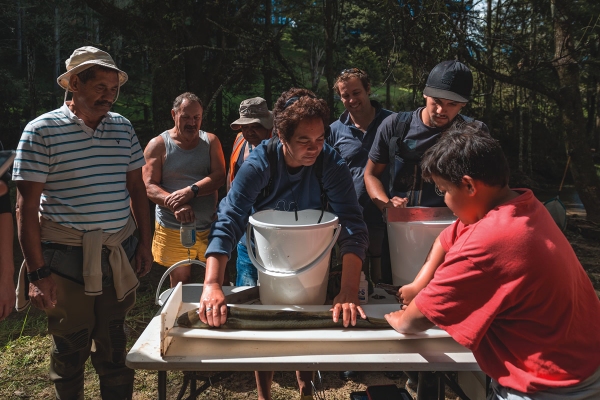Local hapū and NIWA are working together to find out more about juvenile freshwater eels or tuna in streams connecting to the Wairua River in the Wairoa catchment in Northland.
For six years, local hapū collective Ngā Kaitiaki O Ngā Wai Māori has been working with Northpower, NIWA, the Ministry for Primary Industries, Department of Conservation and other agencies to move juvenile eels over the dam as they swim upstream as part of their life cycle.
Ngā Kaitiaki O Ngā Wai Māori and NIWA are now looking at how the juvenile eels, moved over the dam, are surviving. Knowledge gained from the project will help Ngā Kaitiaki O Ngā Wai Māori and supporting agencies in their work to increase tuna populations in the Wairua River catchment.
“There’s very little research being done in New Zealand to learn more about what makes stream habitats suitable for elvers, or juvenile eels, to thrive,” says NIWA scientist and project leader Dr Erica Williams.
“The Wairua River area is like a living laboratory for elver research. So this project is going to be really useful. The more we know about elvers the more effective we can be in helping eels or tuna thrive, not just in this river, but in others around New Zealand as well.”
Declining tuna population
Ngā Kaitiaki O Ngā Wai Māori representative Allan Halliday said there had been long-standing concerns about the declining tuna population.
“This is the result of changes to the landscape like the dam on the Wairua River. This project with NIWA combines mātauranga Māori, or Māori knowledge, and modern day science. We’re blending our two cultures and working together so we can overcome the many obstacles facing tuna on a daily basis.”
The four-year project involves monitoring elvers in streams connected to the Wairua River to assess their health and numbers over time.
Cultural Keystone Species
The project is a component of a new research programme called Cultural Keystone Species, funded by the Ministry of Business, Innovation and Employment.
The Wairua elver research is also supported by the Living Water programme, a partnership between Fonterra and the Department of Conservation – which is working with dairy farmers, iwi, conservation groups, councils, schools and other agencies to improve the health of the Hikurangi subcatchment.

